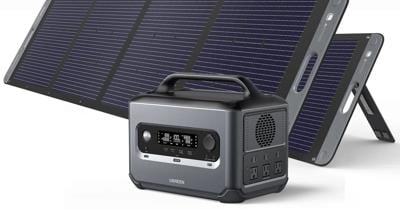I’ve reviewed my share of portable power stations, and when I receive a new one to test, I like to sit down and figure out the target market.
Some power stations are big and heavy, while others are smaller and easier to move around. Some have more battery capacity, some are expandable with extra batteries, and some have inverters with greater capacities to power your largest appliances.
Some power stations are designed to be used as an uninterruptible power source (UPS). If you keep the power station plugged into the wall, any device you plug into the power station’s outlets will keep working if the electricity goes out. If you sleep with a CPAP at night, keeping it plugged into a UPS means you won’t even notice if your home’s power goes out — the CPAP will keep working.
Lately, I’ve been testing the Ugreen PowerRoam 1200, a mid-sized portable power station with a lot of features I was surprised to find for less than $1,000.
Specs
The PowerRoam 1200 has a 1,024 Watt-hour lithium iron phosphate battery that can be recharged from zero to 100 percent in just 1.5 hours from a wall plug.
Lithium iron phosphate batteries have become almost standard on portable power stations. Their predecessors, the lithium-ion batteries, took much longer to charge and had a much shorter usable lifespan.
Lithium-ion batteries could take approximately 300-500 charge cycles and still retain 80 percent of their power, while lithium iron phosphate batteries can provide more than 3,000 cycles and still retain 80 percent of their power.
That means you can drain and recharge this power station every day for almost 10 years before its power capacity dips below 80 percent.
As its name suggests, it has a 1,200 Watt power inverter, which is the amount of electricity it can provide to gadgets and appliances attached to its AC and DC power outlets. It also has a power mode called U-Turbo that can provide up to 2,500W of power for using heavy-duty devices like those that have a more powerful motor (power tools) or heat sources (electric frying pans or hair dryers).
The PowerRoam 1200 has six AC outlets (up to 1,200 watts), one 12v DC car outlet and two additional DC 5521 outlets (120W total), two USB-A ports (22.5W each) and two USB-C power delivery ports (100W each). These USB-C ports can fast charge even the largest laptops.
Three of the AC outlets on the PowerRoam 1200 are true grounded plugs. Most every other power station I’ve tried doesn’t offer grounded outlets, but the Ugreen has a ground post where you can connect it to a ground source.
For power inputs, it has an AC port, a DC input for solar panels or charging from a car port.
The PowerRoam 1200 can recharge from three sources.
It can charge from a regular AC outlet in 1.5 hours, and its power supply is built-in — meaning it only needs a single power cable and not a heavy power brick. It can also charge from solar panels (up to 400W) or from DC power.
Ugreen sells 200-watt solar panels. Two of those panels can charge the power station in just under four hours, depending on the sunlight intensity.
It can charge from DC power. A 24-volt DC plug can charge it in six hours , while a 12v DC outlet (like a car outlet) can charge it in 12 hours.
The PowerRoam 1200 weighs just 25.4 pounds and it measures 13.4 inches by 8.7 inches by 10.6 inches. It has a handle built in on top for one-handed carrying.
It ships with AC power cable, DC cable for a 12v car port, solar panel cable and a DC 5221 cable that all fit in an included zippered pouch.
I also want to mention Ugreen warranties these units for five years.
In use
The PowerRoam 1200 has an app that can connect to the unit via Wi-Fi or Bluetooth. The app shows exactly what’s happening to any connected port and allows the banks of ports to be turned on or off.
It has a bright and clear 4.7-inch LCD screen showing all the inputs and outputs. It isn’t a touchscreen; it only provides information. You can change the settings through the app.
The PowerRoam 1200 has a special mode called Zero Percent Emergency Mode, which can provide enough power to charge your cell phone even after the unit has exhausted its battery. These types of power stations will shut down before the batteries are totally drained for protection, so it must be using some of that reserve.
The app also monitors operating temperatures and lets you set alerts.
The solar panels fold up nicely for storage. In use, they are easy enough to set up and connect, using the included cable. There is a pretty slick aiming assist guide on the solar panels that helps you get the maximum sunlight to the panels.
I had no problem running any gadget I connected, including a hair dryer.
It does have a UPS feature with a 20-millisecond switchover, which should keep your devices going without a hitch if your electricity goes out.
Overall, the PowerRoam 1200 ($999, but look for coupons at ) and 200W Solar Panels ($499) worked well. I could find nothing to complain about. There are certainly larger power stations available, but the Ugreen unit is a nice mix of battery capacity and inverter power in a package that’s easily carried around. It’d be perfect for a weekend camping trip or to keep on hand for emergency use.








